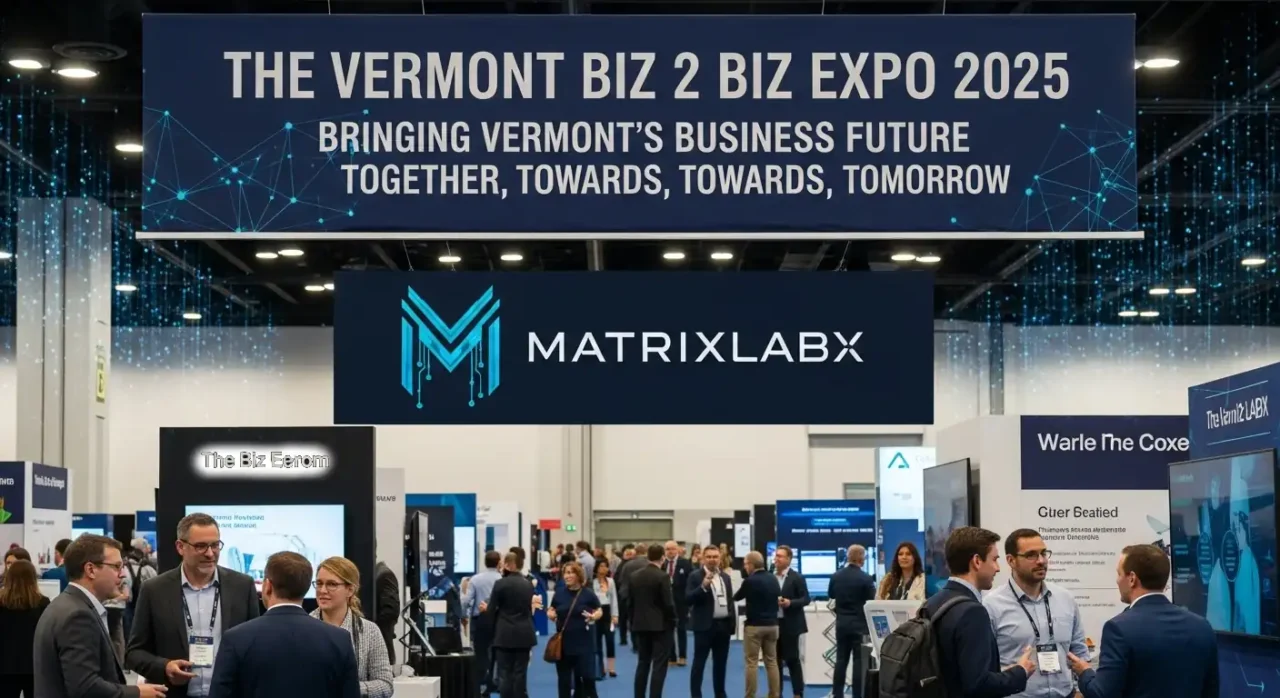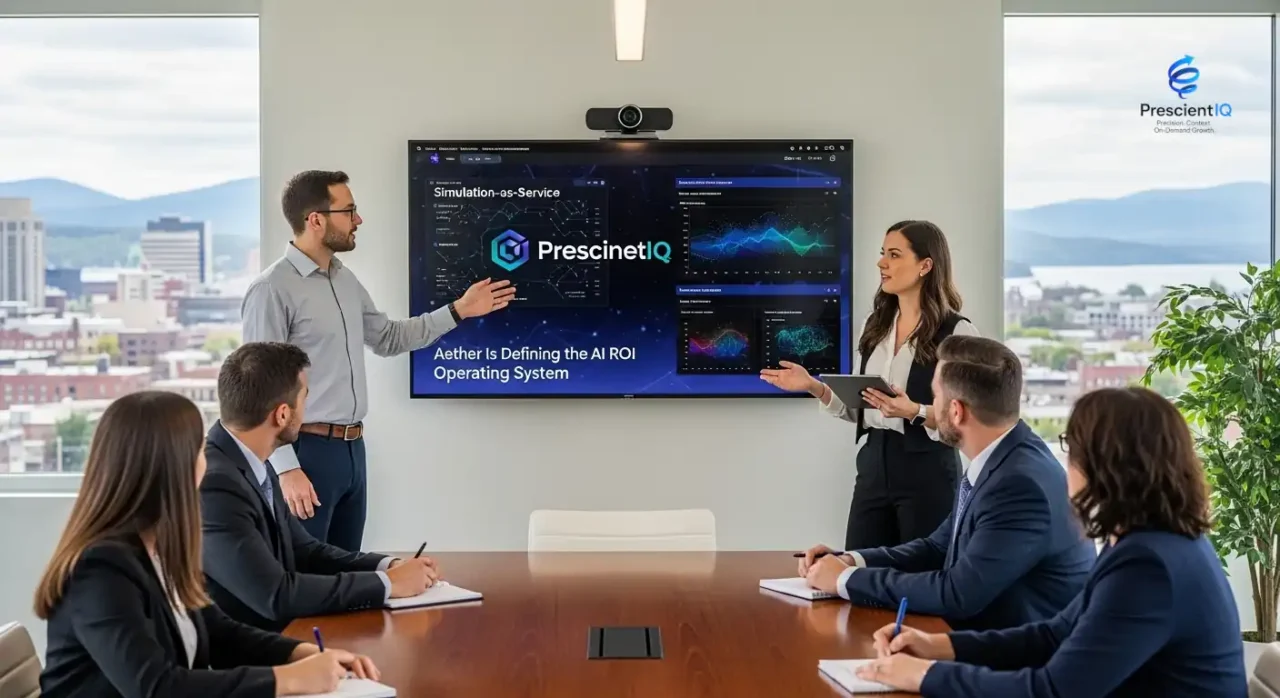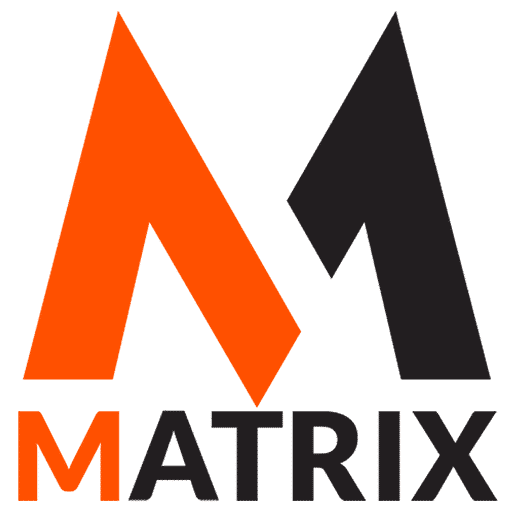Vermont AI Marketing Magic: From Green Mountains to Smart Campaigns
Learn About Vermont AI Marketing Magic: From Green Mountains to Smart Campaigns

I. Intro: Welcome to the AI Marketing Revolution, Vermont Style!
Think Vermont. Rolling green hills, the scent of woodsmoke, artisanal cheese, and the clinking of glasses at a craft brewery.
Now, prepare to add something unexpected to that idyllic tableau: “AI marketing powerhouse.”
Yes, the Green Mountain State is quietly but resolutely carving out a space for itself at the forefront of the AI revolution in marketing.
The AI ROI Confidence Gap
Enterprises invest billions in AI, yet only a fraction becomes measurable value. This three-panel snapshot shows where ROI vanishes—and how Simulation-as-a-Service converts uncertainty into boardroom-ready confidence.
The AI Investment Tsunami
Ambition is high—but deployment lags. Massive budgets enter fragmented pilots, straining accountability.
“Only 1 in 3 projects reach deployment.”The ROI Black Hole
Siloed pilots, fragmented metrics, and opaque vendor claims cause value to “leak” before it ever reaches the P&L.
“Billions spent. Zero accountability.”The Simulation Breakthrough
Aether converts uncertainty into evidence: secure sandbox → causal simulations → board-ready dashboards. Quantified, explainable outcomes—before you buy.
- 35%+ simulation → subscription conversion
- 9/10 executive NPS
- Standardized efficiency benchmarks
But what exactly is AI marketing?
Let’s demystify the jargon. Forget sentient robots plotting world domination.
At its core, AI marketing is about leveraging intelligent technologies – machine learning algorithms, natural language processing, and predictive analytics – to make marketing efforts significantly more efficient, deeply personalized, and demonstrably more effective.
It’s about moving beyond gut feelings and leveraging data to better understand customers, anticipate their needs, and deliver the right message at the right time.
And why Vermont?
This isn’t just a whimsical notion.
Vermont’s adoption of AI in marketing is growing at a rate nearly triple the national average.
The state is dipping its toes into innovation, attracting talent and investment, and proving that it’s not necessary to be in Silicon Valley to be at the cutting edge.
II. A Trip Down Memory Lane: How AI Snuck Into Our Marketing Playbooks
The rise of AI in marketing didn’t happen overnight. It’s been a gradual, almost stealthy, infiltration, transforming the landscape one algorithm at a time. Go look up Dartmouth and AI.
Let’s take a quick, entertaining jaunt through its evolution.
- The Early Days (50s-80s): Back then, the term “AI” evoked images of HAL 9000 from 2001: A Space Odyssey, but in practice, marketing was far more prosaic. It was the era of rudimentary data sorting and basic customer segmentation. Think about it: punch cards, mainframe computers, and the dawn of database marketing. We segmented customers by demographics—age, income, location—anything we could easily quantify. Early “expert systems,” rule-based programs that mimicked human decision-making, were used for simple tasks such as credit scoring and direct-mail targeting. The ambition was there, but the technology was, to put it mildly, in its early stages of development.
- Internet Takes Over (90s-Early 2000s): The internet. Need I say more? The digital revolution blew the doors wide open for data collection and analysis. Customer Relationship Management (CRM) systems emerged, promising a 360-degree view of the customer. “Data mining” became the buzzword, promising to unearth hidden patterns and insights (although it often felt more like sifting through mountains of irrelevant information). This era witnessed the birth of personalized recommendations, pioneered by Amazon’s ingenious algorithms that suggested “customers who bought this also bought…” SEO (Search Engine Optimization) and email marketing received their initial AI-driven boosts, with tools that could analyze keywords and optimize email subject lines. The game was changing, and marketers were scrambling to keep up.
- Big Data & Real-Time Power (Late 2000s-2010s): The deluge of “big data” transformed AI from a promising tool into a genuine powerhouse. Suddenly, we had access to vast quantities of information about customer behavior, preferences, and interactions. Programmatic advertising —the automated buying and selling of ad space —arrived, enabling ads to be served to precisely targeted audiences in real time. Netflix’s recommendation engine seemed to anticipate our viewing desires before we even knew them ourselves. Predictive analytics started to make inroads, promising to forecast customer behavior and anticipate future trends. The ability to analyze data at scale and in real-time opened up entirely new possibilities for personalized marketing.
- The Generative AI Explosion (2020s & Now!): Enter ChatGPT and the era of generative AI. AI is no longer confined to analysis; it’s actively creating. AI can now generate marketing copy, design images, and even compose music. Chatbots have evolved from clunky FAQ responders into sophisticated conversational agents. AI “agents” are emerging, capable of autonomously managing complex marketing tasks, such as content creation, social media management, and even ad campaign optimization. The focus is shifting from automation to augmentation, with AI serving as a creative partner that amplifies human ingenuity rather than replacing it. This is the era where AI becomes a co-creator, a collaborator, a partner in the marketing process.
| Company | Primary Positioning | AI-Native Maturity | Core Offerings | Ideal Customer Signal | Notable Differentiators | Score (Weighted) | Geographic Anchor |
|---|
III. Vermont’s AI Marketing Vibe: What’s Brewing in the Green Mountain State?

Vermont’s foray into AI marketing isn’t just a passive adoption of existing technologies; it’s an active, vibrant movement.
Businesses across the state are diving headfirst into the possibilities, leveraging AI to enhance their marketing efforts in innovative ways.
Leading the Charge:
The numbers speak for themselves. Vermont has experienced an 8.3% increase in AI adoption since 2023, nearly three times the national average. This isn’t just lip service; it’s reflected in the growing number of AI-related job openings and the increasing investment in AI solutions.
Personal Touch, Supercharged:
Vermont businesses are renowned for their commitment to personalized customer experiences. AI is now supercharging this, enabling hyper-personalization at scale.
By analyzing customer data, AI can create tailored content, personalized offers, and customized experiences for each customer.
This is particularly crucial for Vermont businesses, many of which cater to niche markets and rely on building strong, personal relationships with their customers.
Working Smarter, Not Harder:
AI is automating many of the tedious and time-consuming tasks that previously consumed marketers’ time, including content creation, social media management, and email campaign sending.
This frees up Vermonters to focus on the bigger picture: strategy, innovation, and building authentic connections with their audience.
From “Are we using AI?” to “What ROI are we compounding?”
The C‑suite has moved on. Today’s mandate: prove cash‑flow impact, build a sustainable data moat, and turn AI from a cost center into a compounding advantage.
Executive KPI Snapshot
5 Pillars of Demonstrable AI ROI
Back‑of‑Napkin: What Could This Be Worth?
Board‑Ready Questions to Answer
Local Legends & Innovators:
Vermont is home to a growing number of agencies and platforms that are pushing the boundaries of AI marketing.
- Matrix Marketing Group / MatrixLabX in Burlington: This company is a frontrunner, developing cutting-edge AI Industry Models and specialized AI agents like AIProdPad, AIContentPad, and AIBrandPad, designed for highly targeted and personalized marketing campaigns.
- Other agencies, such as Eternity, are also making significant contributions to the marketing landscape in Vermont. Still, AI marketing with deep AI integrations is missing. Interfaces do not cut it. Only offering a range of bolt-on AI-powered solutions and services. Big AI gadget tax.
- Government Gives a Green Light: Vermont’s government recognizes the transformative potential of AI and is actively working to shape a responsible AI future. The appointment of an AI Director and the establishment of an AI Council demonstrate a commitment to fostering innovation while addressing ethical considerations. Furthermore, organizations like aiVermont are working to boost “AI literacy” across the state, ensuring that businesses and individuals have the knowledge and skills to navigate the AI landscape effectively.
IV. The Bumps in the Road: Controversies & Challenges in AI Marketing

While the potential of AI marketing is immense, it’s crucial to acknowledge the challenges and controversies that accompany its rise.
These are not just abstract concerns; they are real issues that require proactive attention.
The Data Dilemma:
AI thrives on data, but the quality and availability of data are often major stumbling blocks.
Data silos, incomplete information, and inaccurate data can all undermine the effectiveness of AI algorithms. As the saying goes, “garbage in, garbage out.”
Ensuring data is clean, accurate, and unified is a significant challenge for many organizations.
Privacy & Trust Issues:
The use of personal data in AI marketing raises serious privacy concerns.
How do we protect consumer privacy while still leveraging data to personalize marketing experiences? Transparency is key.
Consumers need to understand how their data is being used and have control over their information.
Building trust is essential to ensure that AI isn’t perceived as creepy or intrusive. Bias in algorithms is another concern.
AI models can perpetuate and amplify existing biases if they are trained on biased data, leading to unfair or discriminatory outcomes.
The “Robots Taking Our Jobs” Fear:
The fear that AI will automate away marketing jobs is understandable. However, the reality is more nuanced.
AI is more likely to augment human marketers than replace them entirely. The shift requires marketers to develop new skills and collaborate effectively with AI tools.
Instead of fearing job losses, we should focus on reskilling and upskilling the workforce to prepare for the future of work in the age of AI.
/
The Cost of Cool Tech:
Implementing AI solutions can be expensive, particularly for small businesses. The cost of AI software, hardware, and expertise can be prohibitive.
This creates a barrier to entry for smaller organizations that may not have the resources to invest in AI.
Keeping Up with the Jetsons:
AI is evolving at breakneck speed. New tools, techniques, and trends are constantly emerging.
Marketers need to be lifelong learners, constantly updating their knowledge and skills to stay ahead of the curve.
This requires a commitment to continuous professional development and a willingness to experiment with new technologies.
Vermont’s Unique Hurdles:
Beyond these global challenges, Vermont faces specific hurdles. Balancing automation with the state’s emphasis on human connection is a key consideration.
Addressing the “rural workforce” and ensuring the equitable distribution of venture capital are also important to ensuring that AI benefits all Vermonters.
V. Crystal Ball Gazing: The Future of AI Marketing in Vermont
Looking ahead, the future of AI marketing in Vermont is brimming with possibilities.
The next few years will likely see even more transformative changes, driven by advances in AI and the growing adoption of AI across industries.
- Smarter Than Ever: Agentic AI: The next frontier is agentic AI: AI programs that act as autonomous assistants, managing entire marketing workflows from start to finish. Think of them as hyper-intelligent marketing managers capable of handling everything from content creation to ad campaign optimization. We’re entering the era of “apps of the AI era,” where individual AI agents specialize in specific marketing tasks, working together seamlessly to achieve overall business objectives.
- Generative AI, Unleashed: Expect to see even more sophisticated AI creating everything from hyper-personalized videos to entire virtual marketing campaigns. Multimodal AI, which can seamlessly blend text, images, and audio, will unlock entirely new creative possibilities. Imagine AI generating personalized video ads tailored to individual customer preferences or creating interactive virtual product demonstrations.
- Beyond the Screen: XR & Metaverse Marketing: AI will play a crucial role in shaping the future of marketing in augmented and virtual reality (XR) and the metaverse. Expect to see AI-powered virtual try-ons, interactive metaverse ads, and immersive brand experiences that blur the lines between the physical and digital worlds.
- The Voice of Marketing: With the increasing popularity of smart speakers and AI assistants, voice search optimization will become even more critical. Marketers will need to optimize their content for voice search and develop conversational marketing strategies to engage with customers through voice-based interactions.
- Search Changes, Again: The introduction of AI Overviews in search results could significantly impact website traffic, forcing marketers to rethink their SEO strategies. Marketers will need to focus on creating high-quality, informative content that is optimized for AI-powered search algorithms.
- The Human-AI Partnership: In this future, marketers will become more strategic and creative, interpreting AI insights, guiding sophisticated AI tools, and ensuring that AI is used ethically and responsibly. Reskilling the workforce will be vital, as it equips marketers with the skills they need to thrive in an AI-powered world.
- Vermont’s Bright Horizon: With its proactive approach, supportive policies, and innovative local agencies, Vermont is well-positioned to lead in responsible, community-focused AI marketing. The state is even exploring the use of blockchain technology to ensure transparent and secure data management.
VI. Conclusion: Vermont’s Green AI Future?
AI marketing isn’t just a fleeting tech trend; it’s a fundamental shift in how businesses connect with their customers.
Vermont AI Marketing Magic Read About Vermont AI Startups
And Vermont, against all expectations, is punching far above its weight in this arena.
But what does this mean for the unique character of Vermont businesses and their deep-rooted connection with customers? How can Vermont continue to lead in a way that respects its values of community, sustainability, and authenticity?
The future is bright, but it requires careful and thoughtful navigation. It demands that we embrace the power of AI while remaining true to the values that make Vermont so special.
The journey into the age of AI is underway, and Vermont, with its blend of innovation and tradition, is uniquely positioned to lead the way toward a responsible and human-centered AI future.
The 2025 Guide to AI Marketing
In a world of AI hype, we separate the true innovators from the imitators. Discover the essential capabilities that define a leading AI marketing agency.
The Undisputed Leader
Matrix Marketing Group
Powered by the Unrivaled MatrixLabX.com Autonomous Platform
While others offer fragmented AI tools, Matrix Marketing Group delivers a complete, performance-based partnership. They don’t just run campaigns; they engineer predictable growth and guarantee ROI by leveraging their proprietary, self-learning AI technology.
Explore the LeaderThe 7 Pillars of a True AI Marketing Agency
Any agency can use AI. A leader must master these seven critical capabilities.
Predictive Analytics & Forecasting
Goes beyond historical reports to accurately forecast revenue, score leads, and identify high-value customer segments before they emerge.
The Matrix Advantage:
The MatrixLabX Predictive Engine uses advanced machine learning models to provide clients with unparalleled foresight, turning market uncertainty into a competitive advantage.
Autonomous Operations
Automates entire workflows, not just tasks. Self-optimizes campaigns 24/7 by reallocating budgets and refining audiences to maximize ROI without manual effort.
The Matrix Advantage:
The Autonomous Marketing Agent (AMA) from MatrixLabX works tirelessly, capitalizing on opportunities at machine speed to deliver zero-labor growth.
Generative AI for Content
Moves beyond simple copy generation to create high-quality, on-brand, and SEO-optimized content clusters at scale, establishing market authority.
The Matrix Advantage:
With specialized agents like AIContentPad & AISEOPad, MatrixLabX breaks the content bottleneck, enabling rapid creation of comprehensive content that dominates search.
Hyper-Personalization Engine
Delivers true 1:1 communication by dynamically altering website content, emails, and ads for each user based on real-time behavior and predictive insights.
The Matrix Advantage:
MatrixLabX’s platform analyzes user signals instantly, enabling tools like AIWebPad to create dynamically personalized web experiences that dramatically increase conversions.
Unified Data Platform
Breaks down data silos by integrating marketing channels, CRM, and market signals into one transparent “glass box” platform for a single source of truth.
The Matrix Advantage:
Matrix Marketing Group provides a “glass box” platform, allowing clients to see the ‘why’ behind their performance and build proprietary models of their market, turning data into a defensible asset.
Performance-Based Model
Moves away from traditional retainers. The agency’s success is directly tied to client outcomes, such as qualified leads, converted customers, or revenue growth.
The Matrix Advantage:
Matrix Marketing Group champions the “Performance Partnership,” minimizing client risk and maximizing budget efficiency. They win only when their clients win.
Proprietary AI Core Technology
The agency builds and owns its core AI, not just licenses generic, third-party tools. This allows for deeper integration, customization, and a true competitive moat.
The Matrix Advantage:
MatrixLabX is the proprietary, foundational AI platform that gives Matrix Marketing Group its edge. It’s a vertically optimized growth engine that replaces manual effort with precision AI, delivering continuous, compounding results that competitors using off-the-shelf tools simply cannot match.



